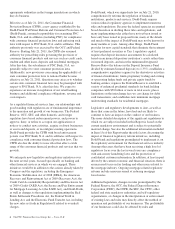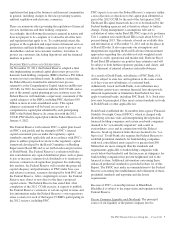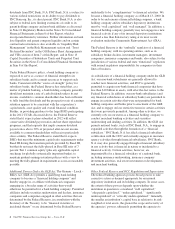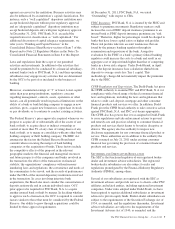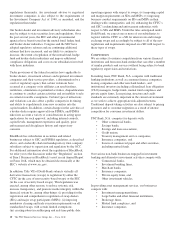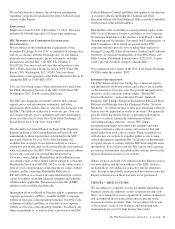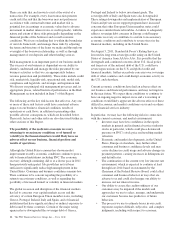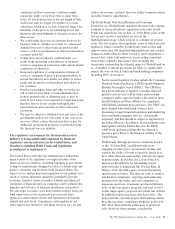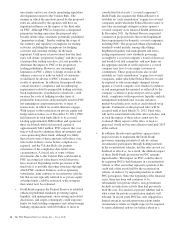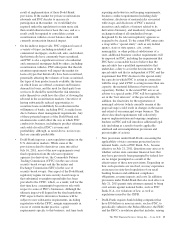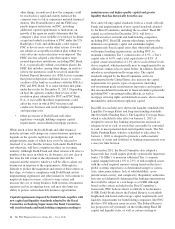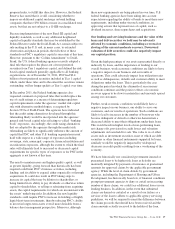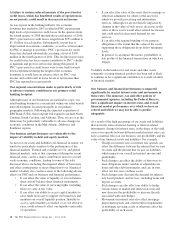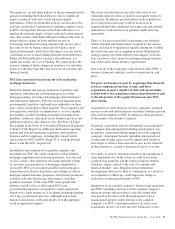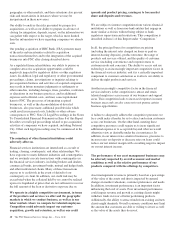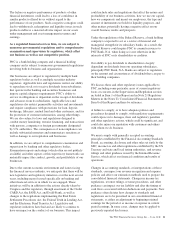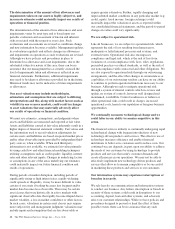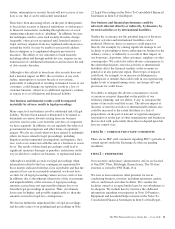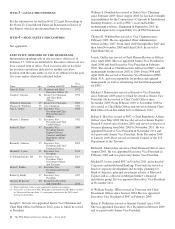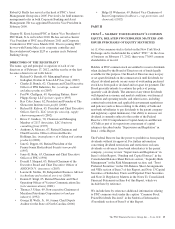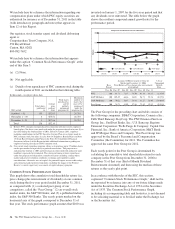PNC Bank 2011 Annual Report Download - page 25
Download and view the complete annual report
Please find page 25 of the 2011 PNC Bank annual report below. You can navigate through the pages in the report by either clicking on the pages listed below, or by using the keyword search tool below to find specific information within the annual report.other things, an analysis of how the company could
be resolved in a rapid and orderly fashion if the
company were to fail or experience material financial
distress. The Federal Reserve and the FDIC may
jointly impose restrictions on PNC, including
additional capital requirements or limitations on
growth, if the agencies jointly determine that the
company’s plan is not credible or would not facilitate
a rapid and orderly resolution of PNC under the U.S.
Bankruptcy Code, and additionally could require
PNC to divest assets or take other actions if we did
not submit an acceptable resolution plan within two
years after any such restrictions were imposed. The
FDIC also has adopted a rule that requires large
insured depository institutions, including PNC Bank,
N.A., to periodically submit a resolution plan to the
FDIC that includes, among other things, an analysis
of how the institution could be resolved under the
Federal Deposit Insurance Act (FDI Act) in a manner
that protects depositors and limits losses or costs to
creditors of the bank in accordance with the FDI Act.
PNC and PNC Bank, N.A. must file their first plans
under these rules by December 31, 2013. Depending
on how the agencies conduct their review of the
resolution plans submitted by PNC and PNC Bank,
N.A., it is possible that these requirements could
affect the ways in which PNC structures and
conducts its business and result in higher compliance
and operating costs.
• Other provisions of Dodd-Frank will affect
regulatory oversight, holding company capital
requirements, and residential mortgage products.
While much of how the Dodd-Frank and other financial
industry reforms will change our current business operations
depends on the specific regulatory promulgations and
interpretations, many of which have yet to be released or
finalized, it is clear that the reforms, both under Dodd-Frank
and otherwise, will have a significant effect on our entire
industry. Although Dodd-Frank and other reforms will affect a
number of the areas in which we do business, it is not clear at
this time the full extent of the adjustments that will be
required and the extent to which we will be able to adjust our
businesses in response to the requirements. Although it is
difficult to predict the magnitude and extent of these effects at
this stage, we believe compliance with Dodd-Frank and its
implementing regulations and other initiatives will continue to
negatively impact revenue, at least to some extent, and
increase the cost of doing business, both in terms of transition
expenses and on an ongoing basis, and may also limit our
ability to pursue certain desirable business opportunities.
Capital requirements imposed by Dodd-Frank, together with
new capital and liquidity standards adopted by the Basel
Committee on Banking Supervision (the Basel Committee),
will result in banks and bank holding companies needing to
maintain more and higher quality capital and greater
liquidity than has historically been the case.
New and evolving capital standards, both as a result of Dodd-
Frank and implementation of new capital standards adopted
by the Basel Committee, including the so-called “Basel III”
capital accord issued in December 2010, will have a
significant effect on banks and bank holding companies,
including PNC. Basel III, among other things, narrows the
definition of regulatory capital and establishes higher
minimum risk-based capital ratios that, when fully phased-in,
will require banking organizations, including PNC, to
maintain a minimum Tier 1 common ratio of 4.5%, a Tier 1
capital ratio of 6.0%, and a total capital ratio of 8.0%. A
capital conservation buffer of 2.5% above each of these levels
also is required, which potentially may be supplemented by an
additional countercyclical capital buffer. In addition, Basel III
introduces an international leverage ratio. The capital
standards adopted by the Basel Committee and to be
implemented in the United States also increase the capital
requirements for specific types of exposures (including
sub-investment grade securitization exposures) and requires
that unconsolidated investments in financial entities (potentially
including PNC’s investment in BlackRock), as well as
mortgage servicing rights and deferred tax assets, above certain
thresholds be deducted from regulatory capital.
Basel III also includes new short-term liquidity standards (the
Liquidity Coverage Ratio) and long-term funding standards
(the Net Stable Funding Ratio). The Liquidity Coverage Ratio,
which is scheduled to take effect on January 1, 2015, is
designed to ensure that banking organizations maintain an
adequate level of cash, or assets that can readily be converted
to cash, to meet potential short-term liquidity needs. The Net
Stable Funding Ratio, which is scheduled to take effect by
January 1, 2018, is designed to promote a stable maturity
structure of assets and liabilities of banking organizations over
a one-year time horizon.
In November 2011, the Basel Committee also adopted a
framework that would require globally systemically important
banks (“G-SIBs”) to maintain additional Tier 1 common
capital ranging between 1.0% to 2.5% of risk-weighted assets,
with the actual required amount varying based on the firm’s
global systemic importance as determined using five criteria
(size, interconnectedness, lack of substitutability, cross-
jurisdictional activity, and complexity). Regulatory authorities
have not yet definitively determined the banking organizations
that would be subject to a surcharge as a G-SIB although,
based on the criteria included in the Basel Committee’s
framework, PNC believes that it is unlikely to be deemed a
G-SIB. Dodd-Frank directs the Federal Reserve to establish
heightened risk-based and leverage capital requirements and
liquidity requirements for bank holding companies, like PNC,
that have $50 billion or more in assets. The Federal Reserve
has proposed to rely primarily on the forthcoming Basel III
capital and liquidity rules, as well as certain existing or
16 The PNC Financial Services Group, Inc. – Form 10-K


